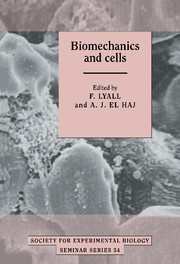Book contents
- Frontmatter
- Contents
- List of contributors
- PART 1 SOFT TISSUE
- Signal transduction pathways in vascular cells exposed to cyclic strain
- Effects of pressure overload on vascular smooth muscle cells
- Effect of increased flow on release of vasoactive substances from vascular endothelial cells
- Modulation of endothelium-derived relaxing factor activity by flow
- Stretch, overload and gene expression in muscle
- Stretch sensitivity in stretch receptor neurones
- Mechanical interactions with plant cells: a selective overview
- Mechanical tensing of cells and chromosome arrangement
- Alterations in gene expression induced by low-frequency, low-intensity electromagnetic fields
- PART 2 HARD TISSUE
- Index
Mechanical interactions with plant cells: a selective overview
Published online by Cambridge University Press: 19 January 2010
- Frontmatter
- Contents
- List of contributors
- PART 1 SOFT TISSUE
- Signal transduction pathways in vascular cells exposed to cyclic strain
- Effects of pressure overload on vascular smooth muscle cells
- Effect of increased flow on release of vasoactive substances from vascular endothelial cells
- Modulation of endothelium-derived relaxing factor activity by flow
- Stretch, overload and gene expression in muscle
- Stretch sensitivity in stretch receptor neurones
- Mechanical interactions with plant cells: a selective overview
- Mechanical tensing of cells and chromosome arrangement
- Alterations in gene expression induced by low-frequency, low-intensity electromagnetic fields
- PART 2 HARD TISSUE
- Index
Summary
Introduction
The study of mechanical interactions between plant cells, and the effects of mechanical stimuli on plant cells, represent an active but fragmented research field which covers many disciplines, ranging from interactions at the level of the ecosystem – in plant communities and in pathogen interactions with crops – to thigmotropic responses and the molecular genetics of gene induction.
The plant cell is surrounded by a rigid wall which normally consists of cellulose and other polysaccharides, and may be thickened with lignin (wood, a complex cross-linked phenolic substance) or subarin (cork). The plasma membrane is contained within the wall. The wall itself generally prohibits the sort of morphogenetic movements that are common-place in animal development and many of those that do occur involve interactions of two distinct cellular genomes with different developmental potentials (Sussex et al., 1985). Hence the range of interactions and perhaps their developmental importance are lower than in animals. Nevertheless, there are advantages in the study of plant systems which can offer possibilities of genetic manipulation and accessibility. As in all studies, interactions between cells involve not only mechanical stimuli, but electrical, hormonal, chemical and nutritional (including water and light) factors, and research is often hindered by the difficulty of separating the different stimuli.
Many aspects of intercellular interaction phenomena in plants are reviewed by Linskens & Heslop-Harrison (1984). A general source of information on the topic of plant cell–cell interactions is given in Sussex et al. (1985), although the individual summaries presented in that book cannot be cited as publications.
- Type
- Chapter
- Information
- Biomechanics and Cells , pp. 107 - 120Publisher: Cambridge University PressPrint publication year: 1994



